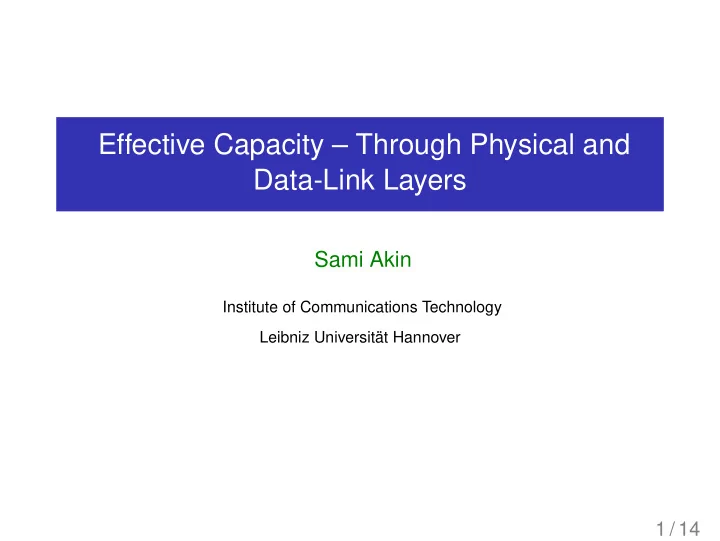

Effective Capacity – Through Physical and Data-Link Layers Sami Akin Institute of Communications Technology Leibniz Universität Hannover 1 / 14
Outline Background and Motivation Effective Capacity Cognitive Radio Concerns and Analyses Conclusion 2 / 14
Background and Motivation In Wireless communications, ◮ The principal design problem in the past: ◮ Time-varying and frequency-selective propagation path ◮ Gaussian noise ◮ Contemporary problems: ◮ Spectrum scarcity ◮ Interference ◮ Power consumption ◮ Change in the objective: ◮ Capacity maximization limited by fading and noise (past) ◮ Network capability, e.g., delay and backlog (recent) 3 / 14
Cross-Layer Concerns Figure: Prospective OSI Figure: Conventional OSI 4 / 14
Effective Capacity Figure: A system with a known stochastic service process s ( t ) ◮ For a stable system, a ( t ) =? ◮ Effective Capacity ◮ Dual of Effective Bandwidth ◮ Maximum constant arrival rate a stochastic service process can sustain under certain QoS constraints specified by θ 1 e − θ � t � τ = 1 s ( τ ) � E C ( θ ) = − lim t θ log e E t →∞ 5 / 14
What to infer from θ ? Figure: Queue in steady-state log Pr { Q > q } θ = − lim q q →∞ ◮ For large q : Pr { Q > q } ≈ e − θ q ◮ Larger θ → stricter constraints on buffer ◮ Smaller θ → looser constraints on buffer ◮ Properties of Effective Capacity: ◮ lim θ → 0 E C ( θ ) = ⇒ average service rate ◮ lim θ →∞ E C ( θ ) = ⇒ minimum service rate 6 / 14
Cognitive Radio A communications model allowing unlicensed (secondary) users to operate in the spectrum with the presence of licensed (primary) users ◮ Access strategies: ◮ Interweave (Channel sensing required) ◮ Underlay (Interference power limitation) ◮ Overlay (Cooperation with licensed users required) ◮ A hybrid strategy of Interweave and Underlay : First: Channel sensing Second: Power level adjustment Third: Transmission 7 / 14
Cognitive Radio Framework Regarding channel sensing decision and its correctness: 1. Channel is busy, and detected as busy (correct sensing) 2. Channel is busy, and detected as idle (miss-detection) 3. Channel is idle, and detected as busy (false alarm) 4. Channel is idle, and detected as idle (correct sensing) 8 / 14
Physical Layer Transmission Framework 9 / 14
Constraints on Cognitive Radios ◮ Channel sensing with errors: False alarms and miss-detections ◮ Strictly limited transmission power levels ◮ Transmission rates that depend on channel sensing results ◮ Increased number of transmission outages ◮ Decreased data transmission rates 10 / 14
Throughput Analysis ◮ Case I: Channel fading is known at the receiver ⋆ Data is forwarded at constant rates depending on channel sensing results ⋆ Transmission outages occur when the rates are greater than the instantaneous channel capacity ⋆ Objective: Rates that maximize the effective capacity under given constraints ◮ Case II: Channel fading is known at both the transmitter and the receiver ⋆ Data is forwarded at rates equal to the capacity regarding channel sensing results ⋆ Transmission outages due to miss-detections ⋆ Objective: Effective capacity performance with channel sensing errors under different channel conditions 11 / 14
Design Concerns ◮ Transmission outages ⋆ When to (not to) take the risk of transmission outages ◮ Channel sensing ⋆ The interplay between the sensing quality and its duration ◮ Input distribution ⋆ Performance investigation with arbitrary input distributions rather than Gaussian distributed signals ◮ Channel estimation ⋆ Imperfect channel estimation results ⋆ Uni-directional effect of channel sensing on channel estimation performance ◮ Channel encoding/decoding ◮ Encoding and decoding performance with different techniques 12 / 14
Asymptotic Analysis Rather than the effective capacity expression, we can utilize certain approximations: ◮ Low signal-to-noise ratio (SNR) regime ⋆ Approximation of the effective capacity when SNR goes to zero ⋆ Good for energy-per-bit investigations ◮ High SNR regime ⋆ Approximation of the effective capacity when SNR goes to infinity ⋆ Good for the analysis of the effects of transmission outages 13 / 14
Conclusion Thank You Questions 14 / 14
Recommend
More recommend